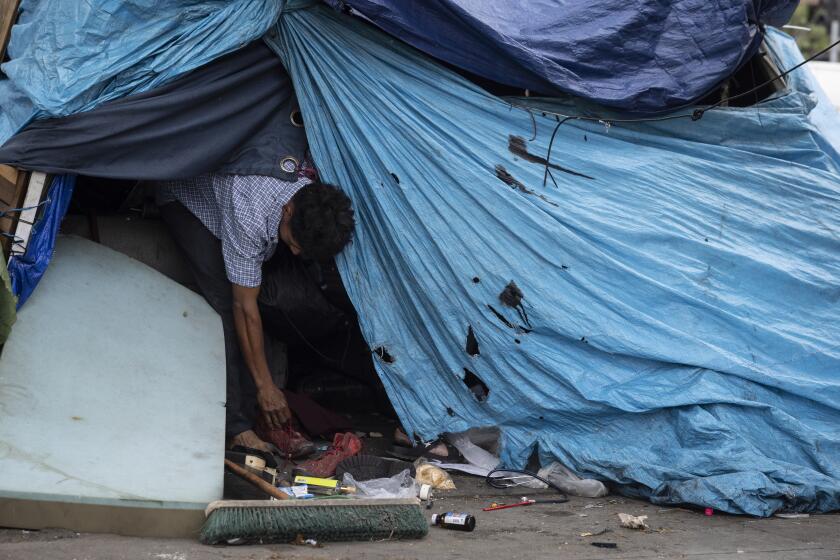L.A. Promises to Clear 9,800 Encampments—But Where Are the Homeless Going?

The Complexities of Homelessness and City Cleanups in Los Angeles
In the heart of East Hollywood, a musician named Dennis Henriquez found himself waking up in an unexpected place—a doorway surrounded by cardboard and a tarp. This was not a scene from a movie but a reality faced by many in Los Angeles. As he stepped outside, he noticed sanitation workers preparing for one of over 30 encampment cleanups scheduled that day.
Henriquez carefully moved his belongings, including a bicycle, backpack, scooter, two guitars, a piece of luggage, and a beach chair, to a nearby grassy area. The city’s sanitation crew then collected the tarp and cardboard, tossing them into a trash truck before leaving him with his scattered possessions. This scenario is part of a larger issue known as CARE-plus cleanups, which occur hundreds of times each week across the city.
These cleanups are part of a five-year legal dispute concerning how the city manages the homelessness crisis. The outcome of this conflict could lead to legal sanctions, financial penalties, or increased oversight of homeless programs. In 2022, city leaders reached a settlement with the nonprofit L.A. Alliance for Human Rights, promising to create 12,915 homeless beds or housing opportunities by June 2027. Additionally, they agreed to remove 9,800 encampments by June 2026, defined as any individual tent, makeshift structure, car, or recreational vehicle.
To meet this goal, the city has been counting each encampment removed during CARE-plus cleanups. However, the alliance has raised concerns about this methodology, arguing that destroying tents without offering housing violates the settlement agreement. Elizabeth Mitchell, an attorney for the alliance, emphasized that any "encampment resolution" must be more permanent and address the broader goal of reducing homelessness.
The city's approach to cleanups is rooted in public safety and accessibility. Sanitation crews argue that these operations are necessary to clear debris and restore sidewalk access for wheelchair users, the elderly, and others. However, the process often feels Sisyphean, as residents frequently return to their original spots after a cleanup.
The alliance has taken legal action, seeking to have the city's homelessness initiatives managed by a third-party receiver. U.S. Dist. Judge David O. Carter initially declined this request but made it clear that he objects to the city's approach. In March, he issued a court order stating that CARE-plus cleanups cannot count toward the encampment reduction goal because they are not permanent. A recent 62-page ruling found the city had "willfully disobeyed" this order.
Attorney Shayla Myers, representing homeless advocacy groups, has long opposed the 9,800 goal, arguing it creates a quota system that risks violating property rights. She believes building housing is the key to addressing the homelessness crisis, not merely removing tents.
City Administrative Officer Matt Szabo explained that the city does not count tents that are temporarily moved during cleanups. However, they do include those that are permanently removed due to public health or safety concerns. He emphasized that while the city offers housing, individuals are not obligated to accept it.
The distinction between different types of city encampment operations is crucial. The Inside Safe initiative moves homeless people into hotel rooms or permanent housing, while CARE cleanups focus on trash removal. CARE-plus cleanups are more comprehensive, requiring the movement of all tents to allow for debris removal and sidewalk powerwashing.
Residents often face uncertainty about upcoming cleanups, as notices are posted on utility poles. If they do not relocate their belongings, they risk losing them. Some items are taken to a downtown storage facility, while others are discarded.
Ryan Cranford, a resident who lost his tent and other belongings, expressed a desire for a motel room. In contrast, Tyson Lewis Angeles chose not to accept a shelter bed due to personal preferences and mental health concerns. Others, like Nicholas Johnson, have suffered significant losses, including cherished items and clothing, leading to feelings of harassment and stress.
As the city continues to work toward meeting its goals, the legal battle over the effectiveness and ethics of these cleanups remains unresolved. Whether the city will challenge the judge's ruling is still unclear, but the ongoing dialogue highlights the complexities of addressing homelessness in a major urban center.
Post a Comment for "L.A. Promises to Clear 9,800 Encampments—But Where Are the Homeless Going?"
Post a Comment